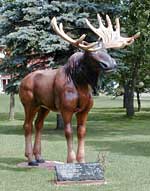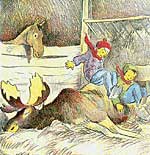By Bob Kelleher
Minnesota Public Radio
November 23, 2001
|
| RealAudio |
A small Iron Range town is reliving its past through a classic children's book - the true tale of a moose that came to town and stayed. First published in 1935, Honk The Moose was out of print for 40 years. Now Honk is back.
| |
|
|
|
||
Forgive Steve Bradach if he starts talking moose. Get the Biwabik mayor talking about city business and you might soon be hearing about his favorite moose - Honk - a real moose whose adventures were captured in a little book more than 70 years ago.
Phil Stong wrote Honk the Moose. He's the same guy who wrote State Fair. Before he was famous, Stong was a Biwabik teacher and apparently a rather mediocre basketball coach. But he'd heard the story of the starving moose that once took up winter residence right beside the horses in a downtown livery stable. So he wrote a book - a book that's near and dear to Mayor Bradach.
"The book is based on a true story. All the characters in the book are real, except the police chief. And that's because he's an Irishman and there were no Irishmen in Biwabik at that time," says Bradach.
Mostly there were Finns, like Ivar and Waino, both 10, who found the bull moose sound asleep in a stable. They fed it handfuls of hay, and named it Honk, for the sound made by the exhausted animal.
Bradach has brought Honk's story back, decades after its 80 pages were last put to print. With savings intended for a summer cabin, Bradach got the rights and printed 6,000 copies of Honk The Moose - a story packed with the names of Biwabik's long gone grandparents, aunts and uncles.
"It really brings back and allow us to recoup some of the heritage here in Biwabik."
Okay, so Bradach's motivations are not purely literary. There's the economic angle. Honk is becoming Biwabik's emblem, something new to draw tourists, and maybe a little something to sell them when they visit.
"They take a piece of Biwabik back with them when they go home," says Bradach.
| |
|
|
|
||
You can find Honk all over Biwabik. There are moose cutouts in yards - a colorful one stands by the door of the Lonely Loon Saloon and Grill. There's a talking moose inside. Down the street, a big, brown fiberglass Honk stands sentinel over the town square.
It took the town a long time to embrace its famous moose, even after the book was first published 70 years ago. Lois Moeller was a new teacher in the late 1930s, when townsfolk met to find the town an historical theme, maybe something based on lumber or iron mining.
"But they already had been taken. So I stood up after all this discussion. I was quite new in town. I said, 'How about Honk The Moose?' And you know three-quarters of the people in that place looked at me like 'she's gone cuckoo.' They had never heard of it," Moeller says.
She decided to change that. She put Honk the Moose in the third grade curriculum.
"It's a very good book, about these boys that were good to this moose, and how they swiped hay from one of the fathers to feed to this moose. And the father, of course, wanted to get him out of town and get him away from the hay, because the kids were swiping it for him," Moeller recalls.
Stong's tale is set in a town called Birora, which is home to Finns and Swedes, Irish and Italians. His young characters poke freely at different ethnicities.
"They sat for a long time, and said nothing. But Ivar was thinking all the time. The more he thought, the more he began to get mad. And then he began to get madder and madder. When a Finn gets mad he doesn't do a halfway job. First he gets madder than a Chinaman - then he works up through the Italians, and the French and on to the English and the Germans. And then, to the Irish. And when he's madder than a Norwegian, he knows that he's a real Suomi."
| |
|
|
|
||
A Suomi - that's a brave Finlander - a Finnish hero.
Honk The Moose is not politically correct, but Maryann Weidt says it's a valuable record. She's a published children's book author and a part-time children's librarian in Duluth.
"I think that teachers could use this as a learning tool for kids to show how people did think at that time."
Weidt has seen many books like Honk the Moose come and go.
"It's sad when books go out of print, and they do quickly. And then they're gone. They're sort of lost to the world," Weidt says.
Honk the Moose was runner-up for the 1936 Newbery Medal for children's literature. It's splashed with bright drawings which won artist Kurt Weise a Lewis Carroll Shelf Award in 1970. It's just been picked a winter feature by Book Sense, an affiliation of independent booksellers.
Demand from bookstores in Biwabik and throughout the region has depleted the first 6,000 copies - another 5,000 are on order. Steve Bradach has been told the book has the potential to sell more than one million copies.
"So we don't really know where this is going to go, but if that happens, Biwabik will really be on the map."
On the map, perhaps, just somewhere down the road from Birora.
More Information



